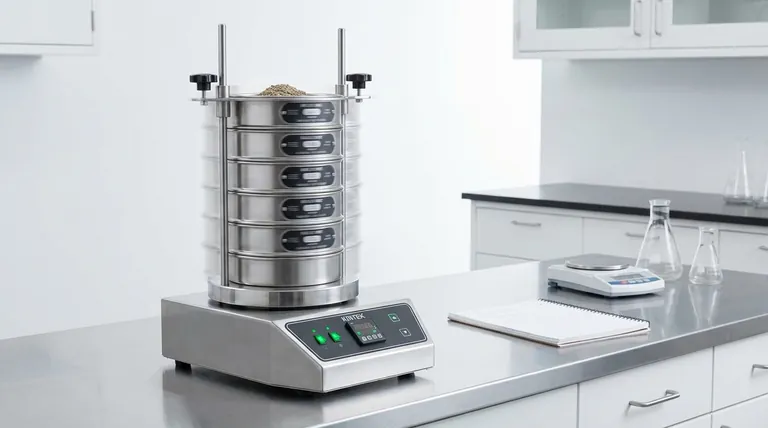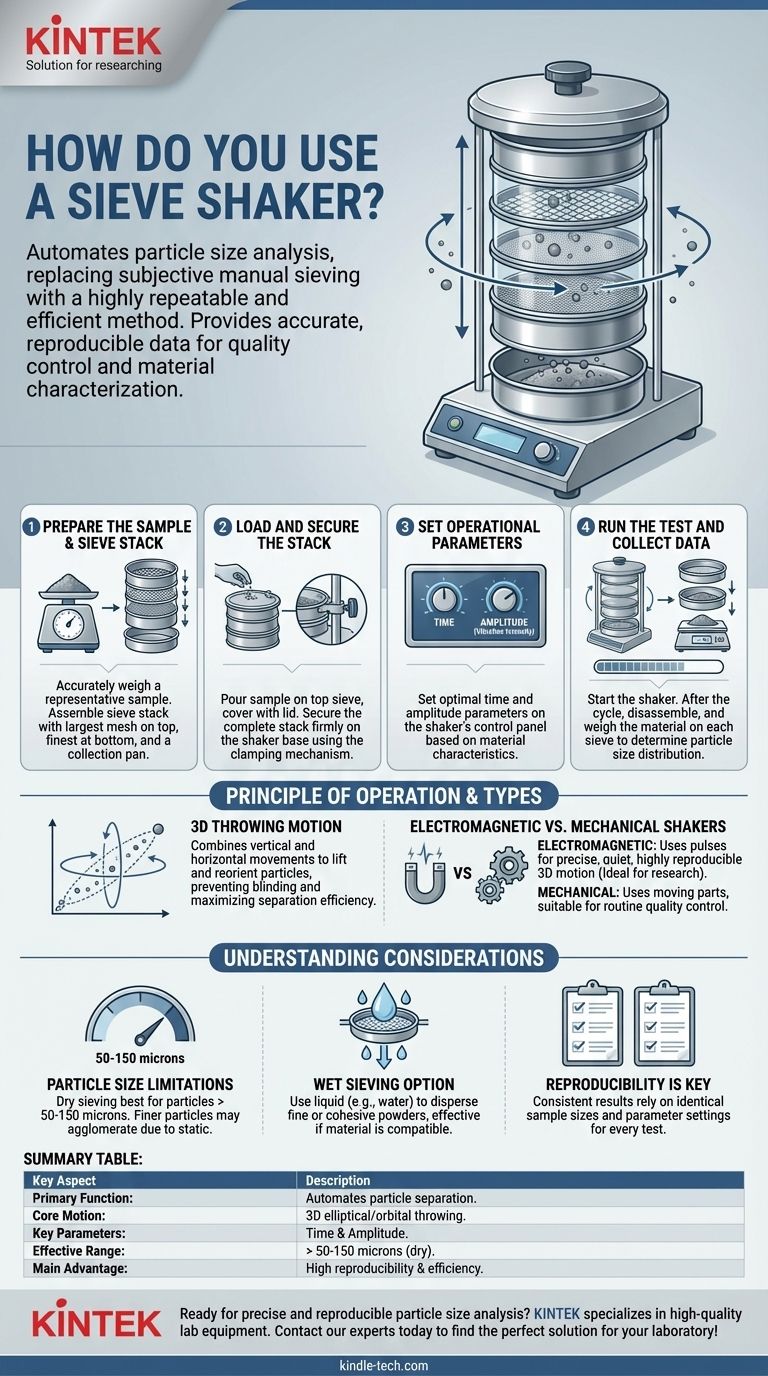To use a sieve shaker, you assemble a stack of sieves with progressively finer mesh from top to bottom, place a precisely weighed sample on the top sieve, and secure the stack in the shaker. The machine then applies a specific motion—typically a 3D elliptical or orbital movement—for a set time, causing particles to pass through the mesh until they are retained on a sieve corresponding to their size.
A sieve shaker automates the process of particle size analysis, replacing subjective manual sieving with a highly repeatable and efficient method. Its true value lies not just in separating materials, but in providing the accurate, reproducible data essential for quality control and material characterization.

The Principle of Operation: How a Sieve Shaker Works
A sieve shaker's primary goal is to ensure every particle has the opportunity to pass through the sieve apertures. It accomplishes this through a specialized, multi-axis motion.
The 3D Throwing Motion
Modern sieve shakers utilize a combination of vertical and horizontal movements. This is often described as a 3D elliptical motion or an orbital throw.
This motion lifts the sample material up and reorients it as it falls back onto the sieve mesh. This constant agitation prevents particles from blinding the mesh and ensures they present themselves to the openings at various angles, maximizing the chance of separation.
Electromagnetic vs. Mechanical Shakers
The most precise shakers are electromagnetic. They use powerful electromagnetic pulses to generate a consistent 3D motion with no moving mechanical parts.
This results in quieter operation and a higher degree of accuracy and reproducibility, which is critical for research and stringent quality control applications.
A Step-by-Step Guide to Sieve Analysis
Following a consistent procedure is the key to achieving reliable results with a sieve shaker.
1. Prepare the Sample and Sieve Stack
First, obtain a representative sample of your material and weigh it accurately.
Next, assemble your sieve stack. The sieves are arranged in descending order, with the largest mesh opening at the top and the finest at the bottom. A solid collection pan is always placed at the very bottom of the stack.
2. Load and Secure the Stack
Carefully pour the pre-weighed sample onto the top sieve. Place a lid on top of the stack to prevent any loss of material during agitation.
Position the complete stack onto the shaker's base and fasten the clamping mechanism. It should be tight enough to prevent movement but not so tight as to damage the sieve frames.
3. Set Operational Parameters
Set the two primary parameters on the shaker's control panel: time and amplitude (intensity of vibration).
The ideal settings depend on the material's density, particle shape, and size distribution. You may need to run a few tests to determine the optimal combination that ensures complete separation without damaging the particles.
4. Run the Test and Collect Data
Start the shaker. Once the cycle is complete, carefully disassemble the stack.
Weigh the material retained on each individual sieve and the bottom collection pan. The sum of these individual weights should be very close to your initial sample weight. This data gives you the particle size distribution of your material.
Understanding the Trade-offs and Considerations
While powerful, a sieve shaker is not a universal solution. Understanding its limitations is key to proper application.
Particle Size Limitations
Dry sieve analysis is most effective for particles down to about 50-150 microns. Below this range, forces like static electricity and cohesion can cause very fine particles to agglomerate, preventing them from passing through the mesh.
The Role of Wet Sieving
For materials that are difficult to sieve dry, wet sieve analysis is an option. This involves using a liquid (typically water) to disperse the particles and carry them through the sieves. This is effective but only possible if the material is not adversely affected by the liquid.
The Importance of Reproducibility
The primary advantage of a shaker over hand sieving is reproducibility. By controlling the motion and time, you eliminate human variability. However, this is only true if you use consistent sample sizes and parameter settings for every test of a given material.
Making the Right Choice for Your Goal
Select your approach based on the specific requirements of your analysis.
- If your primary focus is routine quality control: Prioritize establishing a consistent, repeatable procedure for time, amplitude, and sample weight.
- If your primary focus is high-accuracy research: An electromagnetic shaker is recommended for its precise control and superior reproducibility.
- If your primary focus is working with fine or cohesive powders: Consider wet sieve analysis to overcome particle agglomeration and ensure accurate results.
By mastering this instrument, you gain a reliable method for characterizing and controlling the physical properties of your materials.
Summary Table:
| Key Aspect | Description |
|---|---|
| Primary Function | Automates particle separation for size analysis. |
| Core Motion | 3D elliptical or orbital throwing motion. |
| Key Parameters | Time and Amplitude (vibration intensity). |
| Effective Range | Best for particles > 50-150 microns (dry sieving). |
| Main Advantage | High reproducibility and efficiency vs. manual sieving. |
Ready to achieve precise and reproducible particle size analysis in your lab? KINTEK specializes in high-quality lab equipment, including reliable sieve shakers designed for accurate material characterization and stringent quality control. Contact our experts today to find the perfect solution for your laboratory's specific needs!
Visual Guide

Related Products
- Laboratory Test Sieves and Sieving Machines
- Laboratory Vibratory Sieve Shaker Machine Slap Vibrating Sieve
- High Energy Planetary Ball Mill Machine for Laboratory Horizontal Tank Type
- Laboratory Sterilizer Lab Autoclave Pulse Vacuum Lifting Sterilizer
- Laboratory Sterilizer Lab Autoclave Vertical Pressure Steam Sterilizer for Liquid Crystal Display Automatic Type
People Also Ask
- What are the apparatus used for sieve analysis? Build a Reliable Particle Sizing System
- Which equipment is operated for sieves when perform sieving tests? Achieve Accurate Particle Size Analysis
- What are advantages and disadvantages of sieving method? A Guide to Reliable & Cost-Effective Particle Sizing
- What are the advantages of the sieve method? Achieve Fast, Reliable Particle Size Analysis
- What range of particle size does the sieve analysis apply? Master the 25 Micron to 1 mm Standard



















